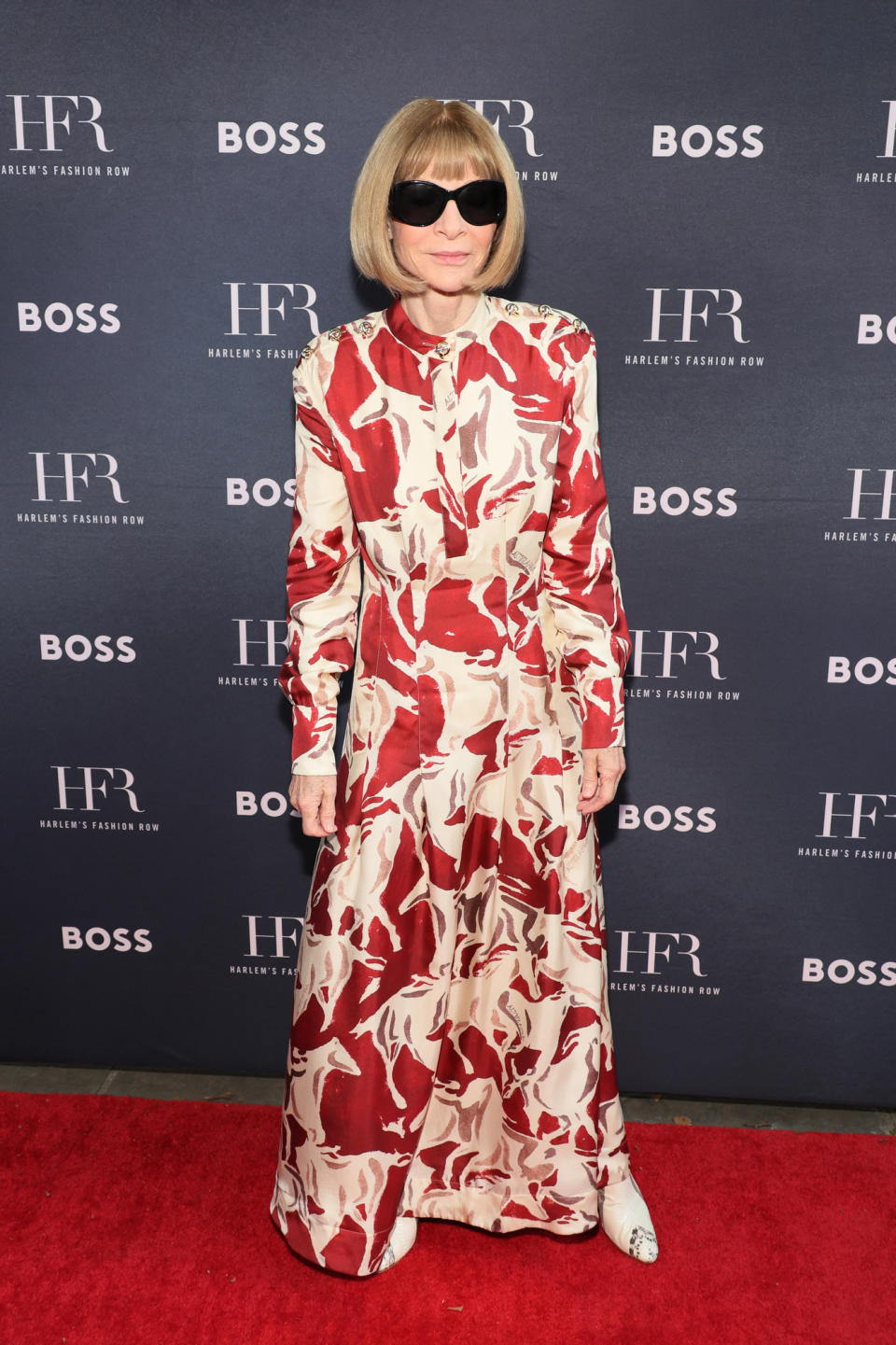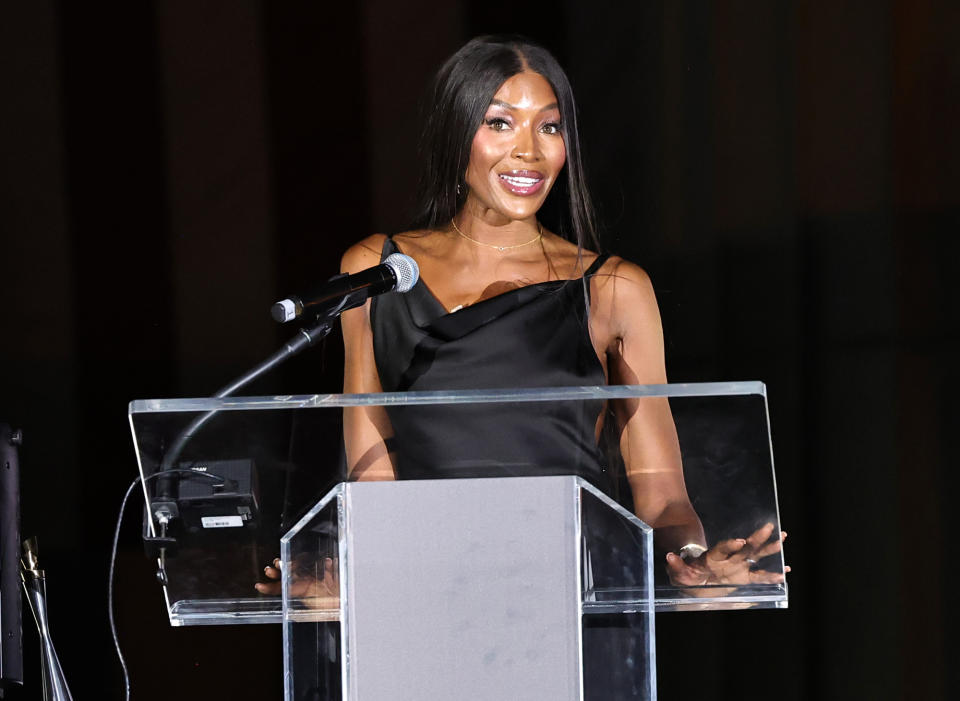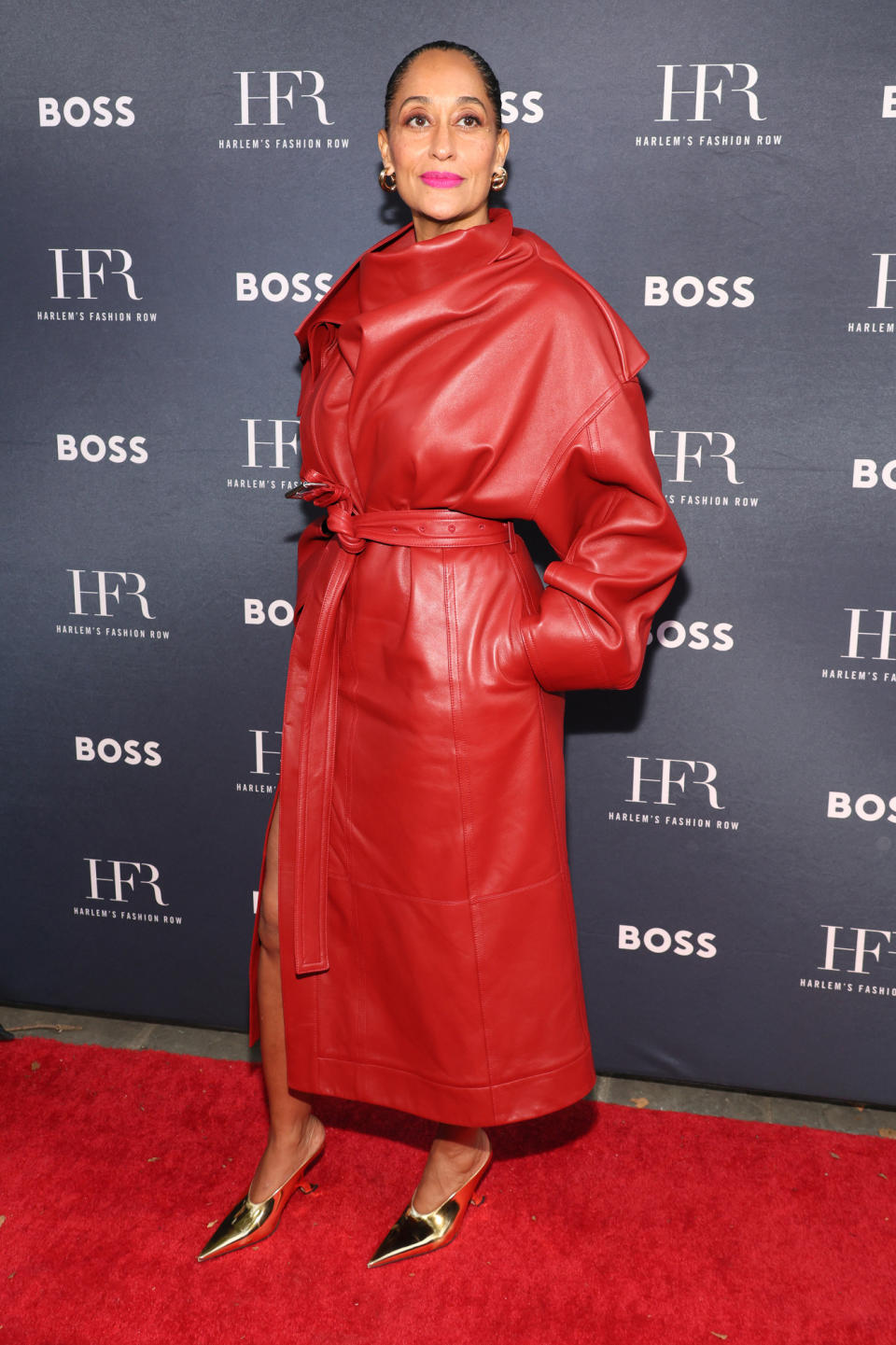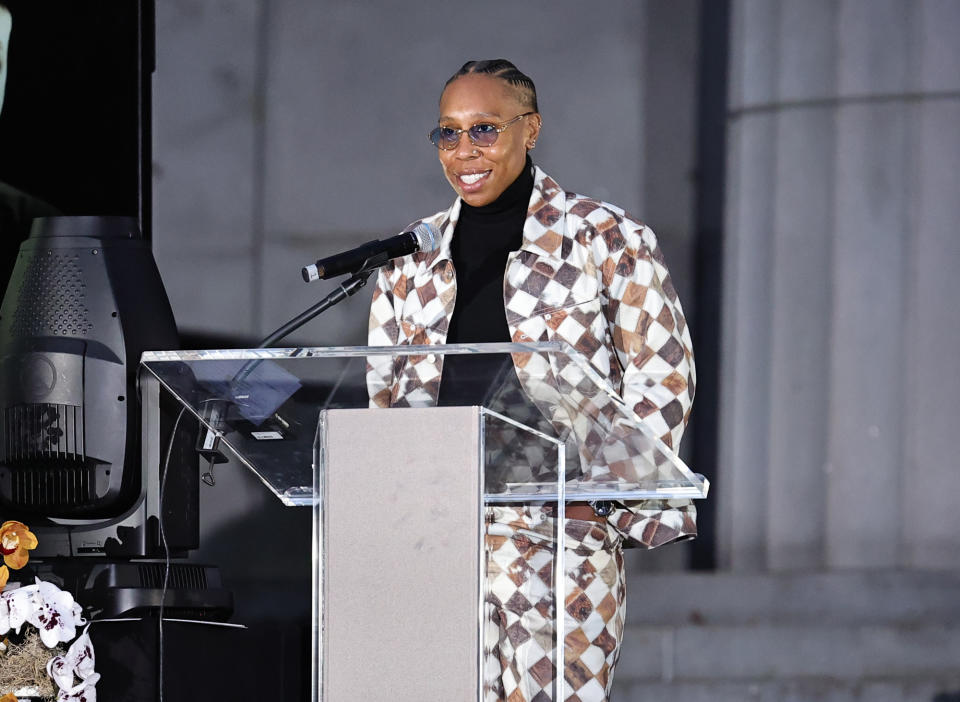Naomi Campbell and Anna Wintour in War of Words at Harlem’s Fashion Row

Instead of starting fashionably late as awards events routinely do, Harlem’s Fashion Row Show and Style Awards got underway promptly Tuesday night at Grant’s Tomb.
In her introductory remarks for the “Night of Legends” event, Harlem’s Fashion Row founder Brandice Daniel encouraged the hundreds of attendees to support Black designers by making at least 10 percent of their apparel and home decor purchases on their creations “to create a shift in the industry.” She also flagged that Black consumers’ spending power for apparel and footwear is expected to reach $70 billion by 2030.
More from WWD
Claudia Schiffer Keeps Summer Alive With a Floral Printed Maxidress for Labor Day in SoHo
Patrick Schwarzenegger and Abby Champion Are the Faces of Tommy Hilfiger's Fall Campaign
Kicking off the program, Condé Nast’s chief content officer and global editorial director Anna Wintour told the crowd that she is “a very punctual person,” and “I have the honor of presenting tonight to someone who is often late [referring to Naomi Campbell, this year’s Icon of the Year honoree]. So Samir [Nasr, editor in chief of Harper’s Bazaar,] has agreed to step in for me.
“Unfortunately, I have to leave after I’ve said everything I would like to say about the extraordinary Naomi Campbell.”

Sources said the scheduled time for Campbell’s award was moved up earlier Tuesday and that the supermodel was already at another press event that she couldn’t leave. A representative from Harlem’s Fashion Row did not to respond to a media request Wednesday. Wintour’s and Campbell’s vehicles were said to have passed each other as Wintour left and Campbell arrived.
Describing Campbell as one of the most fearless people she knows, Wintour said the model started to speak the truth about inequality and injustice at the start of her career — “at a time when it was not so common to do so. Naomi’s bravery has benefited the entire fashion industry.”
A muse to designers such as Marc Jacobs, Virgil Abloh and Azzedine Alaïa, Campbell has also become “a fashion godmother to generations of young models and designers,” Wintour said, noting that Campbell is now a devoted mother to two children, “which is no modest feat, and a champion of global causes especially funding research to fight the AIDS crisis and advocating for its victims.”
Nasr was then saluted as editor of the year by Tracee Ellis Ross, whom she first befriended in 1994 as interns at Mirabella magazine. Four years into her role at Harper’s Bazaar — a first for a Black woman — Nasr said the questions that helped to define her purpose in that post was, “’Who gets to be a part of that record? Who gets to participate in that process to document it for future generations so that they know that we were here?’”

Explaining that she was sharing her award, Nasr said she sincerely hoped that “you recognize something of yourselves and your kin in the stories that we tell and the creative teams that we at Harper’s Bazaar entrust to tell them. My hope is that you feel seen, celebrated and that your stories, our stories — the stories defining this moment and the culture are forever etched into the record of this time.”
Before presenting to Campbell, Nasr explained that she had just been asked by Wintour to do so. “Anna’s one of my first bosses, so when she asks you to do something. [It’s] ‘Yes, ma’am. I am here.’”
Nasr rose to the occasion, describing how she had first met Campbell on a Vogue shoot with photographer Ellen von Unwerth in San Miguel, Mexico. As Grace Coddington’s assistant at that time, Nasr recalled landing a hot-air balloon in the town square, where the supermodel was head-to-toe in Voyage. “You were so warm to me, and kind. I was so nervous to meet you. That trip really left an impression on me,” said the Harper’s Bazaar editor in chief, adding that Campbell is this month’s cover star.

Campbell opened with, “Yes, Naomi’s always late….I want to say this, ‘Everything is meant to work out, the way it is meant to work out. It wasn’t my choice to have the other lady [Wintour]. I would much rather have this [referring to Nasr].”
That apparent slight sent a ripple through the crowd of hundreds and generated some applause. “I have to speak my truth. I’ve always been on a [quest] to be truthful so why change it now at this age?”
Campbell told the crowd how she used to go to Harlem, N.Y., as a teenager to listen to the late Rev. Calvin Butts. One of her last trips to the neighborhood was to attend André Leon Talley’s memorial service, where she arranged for a custom white Schiaparelli ensemble and a vintage white Rolls-Royce. “André wouldn’t have wanted it any other way,” she said.
The supermodel thanked Harlem’s Fashion Row founder Daniel and her team’s “commitment to elevating diverse voices in fashion.” Campbell added, “We must still thank Anna Wintour, as she did take the time to come here to give me the award even though I wasn’t here.”
In her thanks, Campbell said that Wintour started supporting her career in 1987, by “taking a chance on a young Black girl from South London” and giving her a shoot for British Vogue. “I thank you for your influence and your continuing support in pushing fashion forward.”
She also praised the “trailblazers who paved the way for a young Black girl like me” including Bethann Hardison, Iman, Naomi Sims, Beverly Johnson, Sonia Cole and Alva Chinn among others. “These are the women that showed me what to do, when I was 17 or 18 and had been hired by Mr. [Yves] Saint Laurent for my first couture show. I had no idea. I was terrified. They showed me how to take off my cape, execute and watch the chandelier so that it didn’t take off my hat, which it did. I am eternally grateful,” Campbell said.
She also spoke of how her mother and grandmother taught her the value of hard work, perseverance and “to never give up,” sharing the award with them and her two daughters. More than anything, the Icon award is a call to action for the industry from Campbell’s viewpoint. Having just agreed to be part of a company that sells African cotton, Campbell said, “Nothing would please me more than to see the brands come back to the motherland, and buy it from where it originally came from.”
All in all, inclusion extends beyond people featured in advertising and on runways, she said. “It’s about who is controlling the narrative, where we read it and watch it. Who’s getting the money for brands and who’s making decision in the boardrooms? Virgil [Abloh] was one, if not the one, who got a seat at the boardroom table.”
Encouraging young creatives, Campbell said their “talent, vision and determination are not just valuable but vital. We need it to make this business evolve and in a fair and balanced way.” Explaining that she spends a good part of her nonworking time traveling in search of new talent, Campbell said, “I’ve been doing this long enough that I don’t need to do Naomi anymore. Do you know what I mean?”
Calling on attendees “to demand representation on all level across the board,” Campbell said, “Let’s support and uplift each other and redefine what ‘icon’ means. It’s not just the pinnacle of an individual. It’s achievement as a force for collective process.…The fight for equality and for representation in a fashion industry that truly reflects the beautiful diversity of our world is ongoing. I, for one, am not going to slow down until I feel we are equally shared across the world — inside out.”

Accepting the Virgil Abloh award from Corey Smith, vice president of LVMH’s diversity, equity and inclusion, Teyana Taylor spoke emphatically about how growing up in Harlem shaped her style and drive. Explaining that she started a group with her two brothers and a cousin called Team N.E.R.D. [an acronym for Not Everybody Really Doingit], Taylor said they loved Pharrell Williams and rode skateboards and BMX bikes, wearing the “latest dunks and popped-out lenses. But with or without the lenses, it was clear that we had an eye for the look, the moment, the ‘It’ factor.”
But Taylor said her main goal with Team N.E.R.D. was to create a safe space for the kids, who were like herself. “Getting dressed gave us freedom. It was our imagination.”

Another fashion-wise honoree, Shiona Turini received the Stylist of the Year award from Lena Waithe. Turini said she knows “what it feels like to do this work in an industry that often sidelines us or fails to name the part that Black creatives play in sustaining and revitalizing the fashion industry.” The Bermudan costume designer and stylist said she was inspired by June Ambrose, Antoinette Messam and Ruth Carter. “Their hustle and hard work opened doors for so many of us,” Turini said, honoring that she is proud of having spent recent years dressing and collaborating with Black women [including Beyoncé].”

Turini said the honor comes “as efforts are being made to strip away opportunities from Black creatives, efforts to roll back DEI initiatives and policies, efforts to give us watered down versions of Black history and the push against reproductive rights. Our work has never been about fashion only. It’s always been political. We’ve always been the change.”
Before the event wound down, guests watched a runway show featuring collections from Aaron Potts’ A. Potts label, LaTouché and Nicole Benefield. Although Wintour was not there to see their designs, Campbell sat in the front row, cheering at times and later ducking backstage before exiting for the night. As part of Nordstrom’s partnership with Harlem’s Fashion Row, the retailer is offering three exclusive collections from Megan Renee, House of Aama and Harbison.
Best of WWD
U.S. Open 2024 Photos, Live Updates: Simone Biles, Bethenny Frankel and More Celebrity Looks
RFK Jr's Daughter Kick Kennedy's Style Through the Years [PHOTOS]
Sign up for WWD's Newsletter. For the latest news, follow us on Facebook, Twitter, and Instagram.

 Yahoo Lifestyle
Yahoo Lifestyle 
